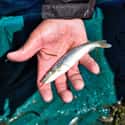-
(#4) Gray Wolf
- Canis lupus
Bounty: $25 per tail
Where: Idaho
Why: Wolf numbers in Idaho have exploded in recent years, and as a result, it has become necessary to offer a bounty on the animals. They were originally endangered, but their recovery has helped establish them successfully through the whole state, which means they need to be managed.
The state has offered up as much as $1,000 for a kill, and since 2011, there have been more than $250,000 in payouts for 470 dead wolves. Hunters are quick to go after these bounties since they pay more than any other animal in the country.
-
(#9) Skunk
- Mephitidae
Bounty: $10 to $150 per tail
Where: Illinois, South Dakota, and other areas around the US.
Why: There aren't a lot of people who like skunks, and there's a good reason for it. They can spray a human if they feel threatened, but more often than not, they're going to spray your dog, and that good boy or girl is going to spread that stink all over you and your house.
In Vernan Hills, a suburb near Chicago, hunters were offered a bounty of $75 per skunk removed from the area. Skunks were also included in South Dakota's Nest Predator Bounty program.
-
(#12) Opossum
- Didelphimorphia
Bounty: $10 per tail
Where: South Dakota
Why: Opossums, North America's only marsupial species, was included in North Dakota's Nest Predator Bounty program alongside many animals on this list.
Opossums are generally harmless to humans, but they do enjoy a tasty snack whenever they stumble upon an unguarded duck or pheasant nest. They were targeted for bounty to limit their population's damage to local birds' nests.
-
(#2) Python
- Python
Bounty: $50+ per snake plus minimum wage ($8.25/hour)
Where: Southern Florida
Why: Pythons are often purchased as pets and cared for by their owners, but after a while, they don't want them anymore. Instead of finding the snake a new home, most people just let it free in the wild, and it's become a serious problem in southern Florida.
Pythons have bred uncontrollably in the Everglades, and because they have no natural predators there, they have become destructive to the native wildlife. Florida has placed a bounty on the snakes, which can be paid in a number of ways. Hunters are paid minimum wage while they hunt pythons, and they receive $50 for 0-4' with an additional $25 per foot after that.
-
(#7) Coyote
- Canis latrans
Bounty: $25 to $75 per tail
Where: Throughout the United States, especially in places like Utah and South Carolina.
Why: Coyotes may look like dogs, but they're far from man's best friend. Like the Australian dingo, coyotes are a breed of feral dogs related to the Grey Wolf, and they aren't domesticated. They tend to eat a lot of small animals, including rabbits, mice, and rats, but they become a pest when they raid the chicken coop.
Bounties are quite common for coyotes, and depending on the area you go after them in, you could walk away with quite a bit of cash. Every state has a different way of handling coyotes, so make sure you follow the local rules and regulations before you start hunting them.
-
(#5) Northern Pikeminnows
Bounty: 1 – 25 fish $5 each, 26 – 200 fish $6 each, 200+ fish $8 each
Where: Pacific Northwest
Why: Pikeminnow are an introduced species in Oregon, Washington, and Idaho, where they have destroyed a great natural resource in the area: salmon. The salmon fishing industry is huge in the Pacific Northwest, and pikeminnows love to eat their babies.
Because of this, the pikeminnow has been targeted for bounties numerous times, and the states have paid out thousands to anglers who catch them. Don't let the picture fool you; they can grow up to 25 lbs., making it possible to reel them in on a fishing line.
New Random Displays Display All By Ranking
About This Tool
Hunting can also be an intervention measure, a way of artificially controlling the number of wild animals. The income from hunting will also be invested in the management and protection of wild animals and the natural environment. An area rich in animal and plant resources will be a paradise for many invasive animals. Because there are almost no natural enemies in the area, invasive animals will grow up wantonly and destroy the ecological balance of the invaded area.
People should clearly recognize the difference between poaching and paid hunting. Many countries have specialized government organizations to control local hunting activities. Department of Natural Resources in America is responsible for the calculation, management, and supervision of legal hunting. The random tool lists 12 invasive animals that people can get paid to hunt.
Our data comes from Ranker, If you want to participate in the ranking of items displayed on this page, please click here.















